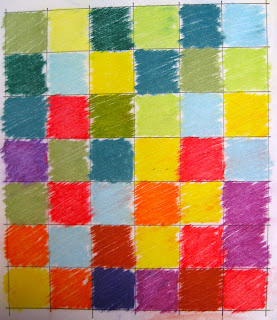Colours are often described in terms of temperature as “cool” or
“warm”. These psychological associations have a lot to do with certain physical
characteristics, like red-fire-warm, yellow-sun-warm or blue-ice-cold,
green-shade-cold. Still, the feeling of warm and cool is relative. The same
color might appear cool in the company of warm yellows and oranges and warm surrounded
by cool greens.
(I’ll look at it closer later this month when talking about contrasts.)
When thinking of the colour wheel, it can be roughly divided in half:
warm colours stretching from red-violet to yellow and cool colours from violet
to yellow green.
Before we go deeper into it, I’d like to make a small exercise.
Please prepare a grid of 6 x 7 squares. Something like it is on the
photo.
Take your coloured pencils or pastels or even your scraps of fabric and
fill the squares of the horizontal rows as follows:
· 1. row: only cool
colours (don’t think much, this is not a beaux-arts competition, chose your
colours randomly.)
· 2. row: 5 cool
colours and 1 warm colour.
· 3. row: 4 cool
colours and 2 warm colours
· 4. row: 3 cool
colours and 3 warm colours
· 5. row: 2 cool
colours and 4 warm colours
· 6. row: 1 cool
colour and 5 warm colours
· 7. row: only warm
colours.
When finished look at the composition. Again try to collect adjectives to
describe the sensation you get with the warm colours on the top and with the
cool colours on the top.
Here is my example:

The warm colours feel much heavier. When they are down, the composition feels stable and static. The top is more airy.
Are the warm colours by the majority on the top, our sensation of balance
is disturbed. A feeling of insecurity, incertitude is coming up and I expect
those “heavy bricks” to fall down and crush all the airy cool bricks below.
So this is again a knowledge we can use consciously in our design. It
works also on the horizontal level. Everything else being equal, warm colours
generally “come forward” in the space. Cool colours, on the other hand, reced
in our vision. Painters often take advantage of this aspect to create the
illusion of depth.
Cezanne used this so called colour-perspective very often, especially in his still lifes:
Just two more examples. First Miro’s Figures at Night Guided by the Phosphorescent Tracks of Snails.
And second a Gee's Bend Quilt von Luisiana P. Bendolph: „Housetop“ Variation
In both the reds are just coming forward, creating the impression of space.
Contrast of temperature can also be used to create mood. Though reactions to colours are somewhat subjective and different from culture to culture, general tendencies apply. Arrangements dominated by cool colours typically evoke feelings of peace, quiet, serenity, and tranquility. Warm arrangements often bring about feelings that are relatively active and dynamic, from vivacity and joy to anger.
In both the reds are just coming forward, creating the impression of space.
Contrast of temperature can also be used to create mood. Though reactions to colours are somewhat subjective and different from culture to culture, general tendencies apply. Arrangements dominated by cool colours typically evoke feelings of peace, quiet, serenity, and tranquility. Warm arrangements often bring about feelings that are relatively active and dynamic, from vivacity and joy to anger.







aujourd'hui j'ai appris quelque chose.Je sais pour les couleurs chaud-froid, mais je n'avais jamais pensé au placement de ces couleurs, merci
ReplyDeleteThat is the first time I ever heard of colors having weight - very interesting concept and it is so true. I have also used value for perspective but never hue. Fascinating!!
ReplyDeleteSo very interesting that you share this including examples of well-known artists, I really appreciate it!
ReplyDeleteArtists of the modern movements worked so much with colour. Try Paul Klee, Vassily Kandinsky, Mark Rothko, Hans Hofman ...
ReplyDeleteI definitely like to weight things on the bottom. How cool that colour has weight! great post!
ReplyDeleteYour color lessons are so helpful! Thank you.
ReplyDeletehey
ReplyDelete